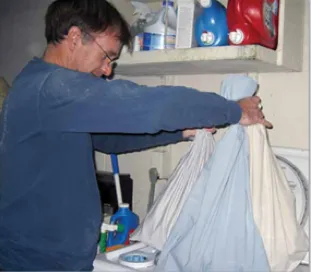Maybe you spent the past season anchored near a highway, airport, or power plant, or maybe you just dragged your mildewed lines out of a locker. The deposits and growth are mostly just an eyesore, but these stains can stiffen the line, make it harder to handle, and cause it to wear more quickly. The good news is that lines are relatively easy to clean. The bad news is that there is a lot of bad advice on how to do it properly. In search of definitive guidance on rope cleaning (See Practical Sailor, July 2011),Practical Sailor contributor Drew Frye turned to manufacturers and professionals for advice. Although the tips varied in some details, all agreed on the following points.
Wash only with a very mild detergent. For relatively new ropes, this means something like Woolite or a half-dose of a modern laundry detergent. For the first few years, ropes still contain thread coatings and lubricants from the factory that provide an easy hand, as well as offer some protection from UV radiation, abrasion, and water absorption. Washing a new rope in a cleaner touted as degreaser will harm this protective coating. After several years, when these lubricants have clearly been washed away by rain and worn off by normal use, ordinary laundry detergents at ordinary doses are acceptable. Avoid any cleaners that have a pH value below 7 or above 9, exaggerated soaking periods, or exaggerated doses. Most common laundry detergents are buffered in this pH range when used as directed.
Wash on the gentlest cycle. The rope should be tightly coiled or tied in a daisy-chain, and then placed inside a pillowcase. Front-loading washing machines are recommended; an up-and-down motion is preferable to the rotary motion of most common household machines. Without coiling or daisy-chaining, a rope can turn into an impressive tangle. The pillowcase further restricts the motion of the rope and prevents the rope from wrapping around the central agitator, which can destroy ropes and break washing machines. For a video of daisy chaining, search chain sinnet (also called a monkey braid) on www.animatedknots.com.
Avoid contact with acids, bases, and solvents. Both polyester and nylon (polyamide) are vulnerable to certain chemicals, so manufacturers broadly warn against using them. However, both nylon and polyester are unaffected by most solvents. Extended exposure to certain alcohols can weaken polyester. Both nylon and polyester have some vulnerability to alkalis such as those found in strong cleaners like TSP (trisodium phosphate) or Spick-N-Span.
Nylon is particularly vulnerable to acid. Strong acids such as battery acid or muriatic acid can literally melt right through a nylon rope in a matter of minutes. Soaking for an hour in weak acid cleaners (typically based on phosphoric acid, oxalic acid, citric acid, or acetic acid) such as Lime-Away or Shower Power can weaken the rope by as much as 50 percent without any worthwhile cleaning benefits. Avoid all acid cleaners, including vinegar, and diluted acids.
Fabric softener at recommended doses is approved. However, high doses of fabric softener can weaken ropes, primarily because they prevent complete drying.
Power washing is not recommended. While it can be an effective method for cleaning marine growth from mooring pendants and dock lines, a power washer in the hands of an inexperienced operator can do significant damage. High-pressure water can easily cut through a line and do significant hidden damage. Power washing can be carried out safely by keeping the power-washer nozzle at a sufficient distance, but there is no easy way to tell whether your work is causing some hidden damage.
Bleach is not recommended by any manufacturer in any quantity. Every manufacturer has faced claims of rope failure or splice failure caused by a bleach overdose. Extended soaking in bleach solutions must be avoided.
Hot water is not a problem. Nylon and polyester are undamaged at normal water-heater temperatures (120 to 135 degrees).
Dont dry with heat. The rope should be flaked loosely on the floor or ground and left to dry. Nylon and polyester ropes are not typically heat-set, and there is great risk that the sheath and core will shrink differently, causing distortion and structural damage to the rope.
The following additional experience was volunteered by professional riggers:
Washing wont make splicing easier. Old double-braid is difficult to splice, and washing doesn’t change that. Polyester remains too stiff, even if treated with fabric softener.
Washing machines don’t like nylon double-braid. Nylon double-braid is subject to herniation and destruction during the machine-washing process. Never machine wash a new or nearly new nylon dock line.
Bleach is very bad (again). This one is worth repeating. Each spring, riggers are asked to re-do splices that have come loose after bleach ate the stitching and whippings that secured the splices. Without a few key stitches, a splice will be milked apart in 30 minutes of agitation.
For more detail on how clean your ropes, as well as a look as a graphic demonstration of what can happen when you do it wrong, see the July 2011 article.

































